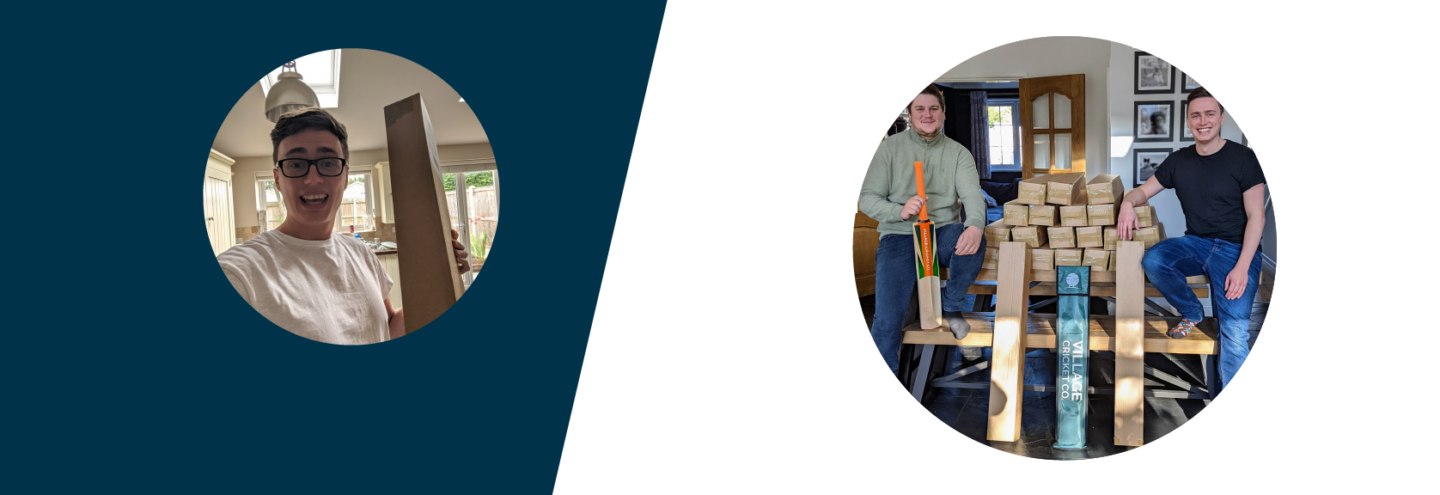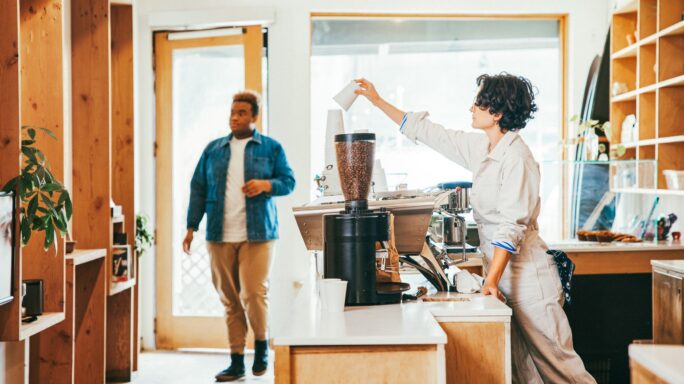How it started: Lockdown. How it’s going: We made cricket more accessible
Discover how the founders of Village Cricket Co overcame challenges to tackle the learning curve of starting a new business.

Can you build a quality cricket bat on a budget? The founders of Village Cricket Co, Freddie Chatt and George Simmons, say yes.
This determined duo started their business to make cricket more accessible than ever, using their combined 20+ years’ experience to build a brand-new bat to take village cricket to the next level.
Here’s what we cover in this article:
How Village Cricket Co started
Starting an online business: Costs and experience
Going from side hustle to business
Bowled over with positive sales
Freddie and George’s message to budding business owners
Village Cricket Co fact file
Business name: Village Cricket Co., @villagecricketco
Founders: Freddie Chatt (@freddiechatt) and George Simmons
Year started: April 2020
Location: Essex
How Village Cricket Co started
A few seasons ago, my cricket bat broke.
It was, of course, gutting. I loved the bat, but it was also exciting as buying a new one is such a fun experience for cricketers, no matter how long they’ve been playing for.
It had been a few years since I’d bought a new bat but some of the prices seemed insane. So many were upward of three, four, even £500 and some cost even more.
It made us wonder, what would it take to create a cricket bat that was both affordable and suitable for people like us, playing village cricket?
What this triggered was a multi-year obsession with the behind the scenes of cricket bat manufacturing, from tours of UK-based brands’ processes, going to see the willow trees being planted, and so on. It got deep.
Challenging the status quo
We challenged people’s ideas and beliefs when it came to cricket bats.
The strongest belief held by almost every player we spoke to was that English willow is vastly better than Kashmir willow. To the point where Kashmir willow has been said to only be useful for playing with tennis balls.
But what if this wasn’t the case?
After all, Kashmir willow is used commonly among Indian recreational players and was even used by Sachin Tendulkar and Sir Viv Richards at points during their careers.
We naturally had our own doubts since this was such a long-held, strong belief voiced across the cricketing community.
So, we looked into it.
We sourced some sample bats directly from India, using the highest grade of Kashmir willow before the 2019 season began to test if they would survive a match, let alone a season.
We were astounded that the bats held up exactly the same as the ones we used previously, costing around £200 to £300.
They had the same pickup, the same ping when you middle it—the edges even seemed to fly, which was fortunate for us.
We were sold, but would everyone else be? To test that theory, we got some clubmates to try them out and they were blown away, and actually became our first customers.
The rest of the story is pretty obvious, to the point that we probably wouldn’t have set up Village Cricket Co if the bats hadn’t performed so well.
Starting an online business: Costs and experience
Freddie worked for an e-commerce brand for seven years in a digital marketing role, so he knew certain elements of promoting the business.
But there was definitely a bit more of a learning curve than we anticipated.
We both put in an initial £1,000 each, so our total capital was £2,000.
This was enough to buy our first batch of 50 cricket bats from India, and for a few extra things like the domain and hosting for the website. Since we’re an e-commerce business, that’s all we needed to get started.
Setting up the website was relatively straightforward, but adding payment methods and covering the legal side of things like GDPR was something of a challenge.
The logistical nature of the business in terms of importing the bats into the country was another one, mainly because we had to ensure we don’t get hit with any unexpected costs.
Even though the first batch of bats were safely stored away in the garage, we needed—and almost forgot—to account for boxes to pack them in, protective packaging materials, and labels.
We’re still quite small, so finances are quite straightforward, but this is something we’ll need to learn and scale as we grow more.
Going from side hustle to business
We started the business together as a fun side project that we saw a big future in.
We know it’s a long game and the work has only just begun, but the fact is we’ve managed to get started which for us feels like a great step and cannot wait for what’s to come.
We worked upward of 20 hours a week on top of our existing jobs to get this off the ground.
It took some time to get the website to a point we were happy to start sharing it, but we essentially did everything ourselves through a combination of existing knowledge and Googling how to do things.
When it came to building a customer base, we started with our own cricket club, and they have all been super supportive and we’ve since donated several bats to our junior cricket section too.
This helped us get some great feedback on our products so we could make improvements.
Using Freddie’s knowledge of SEO, we’ve also created targeted content around what we know our audience is searching for in Google.
This is a long-term campaign that will hopefully send us more traffic each year we’re in business.
We also focused heavily on building our email list through giveaways, some in partnership with non-competing brands within our industry. Through this, we’ve built an audience of over 2,500 that we can engage with every week.
Social media is a fantastic tool for small business owners.
We try to post regularly on our platforms to build up and engage with our audience on multiple channels.
But this has taken a lot longer than we thought and calls for more resource than we have right now, so is definitely something we can develop as we grow.
Of setbacks and stock levels
Our major setback was obviously the pandemic when we first launched, as the cricket season was cut in half.
Plenty of players decided to not even participate in any cricket at all, so our market was much smaller to start with.
Because of this, we decided to start planning for the next season straight away. We built up our marketing plan for the next year and started setting things in motion to ensure we were as prepared as possible.
We ran out of stock in April, just weeks after the season started, and frantically tried to get more stock in to not miss out on sales or disappoint our customers.
We’re now better prepared with our lead times on stock levels so know when we need to order more inventory in future.
Lessons learnt: Stay on top of stock management
If you’re selling a physical product, get to grips with stock management as soon as possible.
Not long after the season started, we went out of stock as our product resonated much more than we ever thought it would.
We had to wait over six weeks for new stock to come in and even with accepting pre-orders for the new batch we still probably missed out on a lot of sales.
We learnt from that, so now we plan to make sure this does not happen.
Bowled over with positive sales
We sold out of our first batch of 50 bats within two weeks of most people starting to play cricket when lockdown eased at the very end of March.
We are now well on our way to selling out of our second batch of 300 bats, which includes a full range of junior-sized bats, before the end of the season and are likely to have to replenish to cover all sales for the rest of the year.
Right now, we’re looking to expand our range of products even further in 2022, and potentially even take on some funding to further expand the business.
We started simple with just a single product—an adult cricket bat—and expanded into other sizes this year.
In the next six to 12 months, we’d love to take on a small amount of additional capital to expand into a full range of affordable protective equipment for village cricketers.
Freddie and George’s message to budding business owners
The best time to start is now.
Regardless of your business, knowing your financial numbers will mean you always know the health of your business. Don’t chase vanity metrics that won’t help your business grow.
And always be talking to your customers—or potential customers—to understand why they bought from you or why they didn’t.
How it started, how it’s going
Want to know what year one of business is really like? A group of business owners share their stories and advice to help you navigate the start of your entrepreneurial journey.







Ask the author a question or share your advice